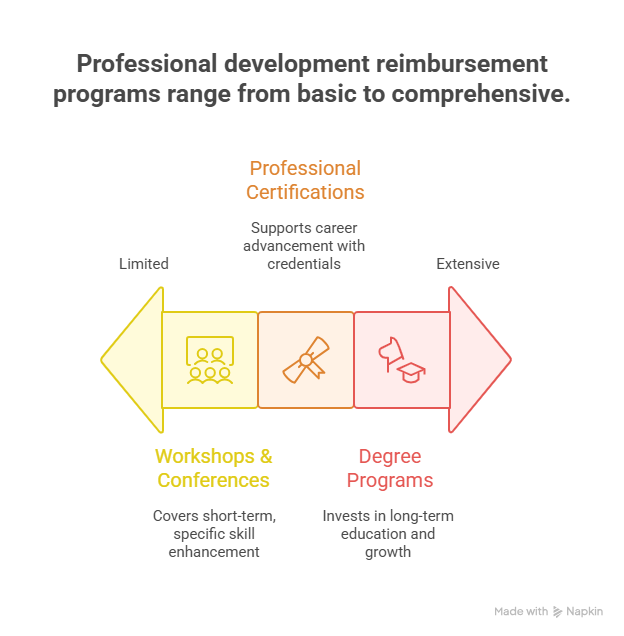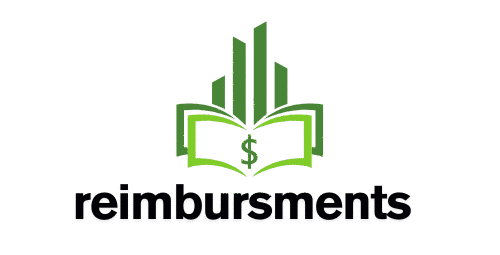Did you know that each year, millions of dollars in employer-sponsored education benefits are not claimed? This startling figure reveals a serious oversight on the part of workers who could be improving their knowledge and abilities at the expense of their employer.
If you follow the correct procedures, claiming reimbursement for professional development can be a simple process. This post will walk you through the procedure and offer helpful reimbursement advice to help you maximize the educational benefits offered by your employer.
After reading this article, you will have the information necessary to easily navigate your company’s reimbursement policies and make sure you don’t lose out on any opportunities.
Understanding Professional Development Reimbursement Programs
Workers can greatly improve their career prospects by being aware of professional development funding strategies. Programs for professional development reimbursement are intended to help staff members advance their knowledge and abilities, which will ultimately benefit the company.
Common Types of Reimbursable Professional Development
Generally speaking, employers cover costs for conferences, certifications, and training that correspond with an employee’s position or potential career paths within the company. This may consist of:
- Degree programs and online courses
- Certifications for professionals
- Workshops and conferences for the industry
Typical Employer Policies and Limitations
Understanding the particulars of your employer’s program, such as any caps on reimbursement amounts, eligible expenses, and necessary documentation, is essential to navigating tuition reimbursement policies. Reviewing your company’s policies is essential because employers frequently have different policies.
| Policy Aspect | Typical Details |
|---|---|
| Reimbursement Cap | Annual limits, e.g., $5,000 |
| Eligible Expenses | Tuition, books, materials |
| Required Documentation | Receipts, course syllabi, completion certificates |
Benefits of Utilizing Company-Sponsored Education
In addition to improving your skills, using company-sponsored education shows that you are dedicated to the company and your career. Important advantages include:
- Improved opportunities for employment
- A higher level of job satisfaction
- Improved conformity to business objectives

Employees can actively pursue their professional development by comprehending and utilizing these programs.
Preparing Your Reimbursement Request
Writing a strong request that supports the goals of your business is crucial when requesting reimbursement for professional development. This entails a number of crucial actions that guarantee the approval of your request.
Researching Your Company’s Specific Policies
A successful reimbursement request starts with an understanding of your company’s professional development policies. To learn more about the kinds of expenses that qualify for reimbursement and any particular submission requirements, go through your employee handbook or speak with HR.
Aligning Development Goals with Business Needs
Make sure that your professional development goals are in line with the business objectives of your organization in order to support your request. This illustrates how your development helps the company succeed.
Building a Compelling Business Case
A successful reimbursement request requires a solid business case. This entails showcasing the skill gaps your professional development will fill and proving return on investment.
Demonstrating Return on Investment
Demonstrate how your professional growth will eventually help the business, whether it be through higher output, better abilities, or happier employees.
Highlighting Skill Gaps You’ll Address
Describe the precise skill gaps that your professional development will fill and the advantages that closing these gaps will have for both your work and the company.
Professional Development Reimbursement Tips for Successful Claims
The first step in making the most of your employee development funds is understanding how to efficiently handle your company’s reimbursement procedure. You can guarantee a successful and seamless reimbursement process by being aware of the nuances of your company’s policies.
Documentation Requirements and Best Practices
The foundation of a successful reimbursement claim is appropriate documentation.Maintain thorough records of every expense, including invoices and receipts. Keeping a record of how the professional development activity fits with your job requirements and the objectives of the company is also crucial.
Timing Your Submission Strategically
When it comes to submitting your reimbursement request, timing is crucial.Make a plan and file your claims when your business is most likely to respond to them promptly.
Following Up on Pending Requests
Do not hesitate to follow up if your request is still pending. A professional and courteous question can speed up the procedure.
What to Do If Your Request Is Denied
Learn the reasons for the denial if your reimbursement request is rejected.Examine your organization’s policies, and think about contesting the ruling or looking into other funding sources.
Appeal Strategies
Provide fresh information or address any misunderstandings when contesting a request that has been denied. Emphasize the advantages of the professional development activity for the business.
Alternative Funding Options
Investigate other funding options, such as professional associations or educational institutions that provide grants or scholarships, if your request is rejected and an appeal is not practical.
Investing in Your Professional Future
You can open up new avenues for professional development by comprehending and utilizing the rules of your company’s tuition assistance program. The secret is to match your academic goals with your professional requirements so that you and your employer benefit equally.
As was mentioned, two essential steps in the procedure are creating a strong reimbursement request and pursuing unresolved claims. By doing this, you can improve your career prospects and take advantage of all the benefits that are available to you.
Putting money into your professional development is a wise decision that advances both your career and the success of your company as a whole. Investigate the reimbursement plans offered by your organization to begin the process of creating a more promising career.
FAQ
What types of professional development are typically reimbursable under employer-sponsored education programs?
The majority of businesses pay for training programs, certifications, and courses that improve job-specific skills and meet business needs. This can include online courses in your field, conferences, workshops, and degree programs.
How do I maximize my professional development budget?
Prioritize development opportunities that directly affect your job performance and fit with business objectives in order to get the most out of your budget. To pay for extra costs, think about combining company reimbursement with outside funding sources or scholarships.
What are some effective strategies for navigating tuition reimbursement policies?
Learn about your company’s tuition reimbursement policies, including any reimbursement caps, programs that qualify, and the paperwork needed. To improve the possibility of approval, make sure your development goals are in line with business objectives and plan ahead.
How can I build a compelling business case for professional development reimbursement?
Highlight the abilities you will gain, the effect on your work performance, and the possible return on investment to show how your development goals will help the business. Describe in detail how your improved abilities will support organizational goals.
What should I do if my professional development reimbursement request is denied?
Ask for an explanation if your request is turned down. If you think the decision was made incorrectly, you might want to appeal it. As an alternative, look into other funding sources like personal financing plans or outside scholarships.
How can I optimize my employee development funds?
Make sure your development activities are well-planned and in line with business priorities to get the most out of your investment. To prevent missing deadlines or going over budget, keep thorough records of your expenses and promptly submit reimbursement requests.
Are there any best practices for documenting professional development expenses?
Yes, keep thorough records of all the costs associated with your professional growth, including invoices, receipts, and evidence of payment. To expedite the submission process, arrange these documents in accordance with your company’s reimbursement requirements.
Can I use professional development reimbursement for online courses or MOOCs?
Online courses or MOOCs (Massive Open Online Courses) that are pertinent to your work or professional development are often reimbursed by employers. To find out whether these courses qualify for reimbursement, review your company’s policies.




